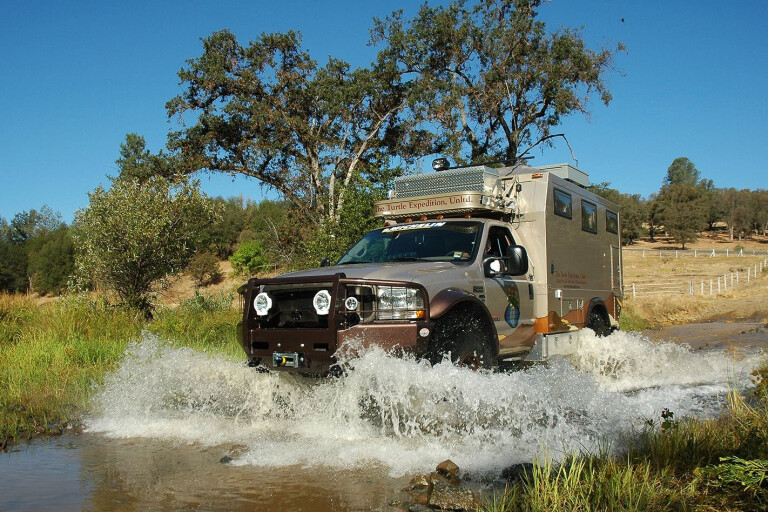
THE NAMES Gary and Monika Wescott are as familiar to overlanding circles as Mallory and Hillary are to mountaineers. They have been weaving an intricate web of tracks across and around our blue planet since the 1970s.
Tales of their adventures have been featured on television shows, in international newspapers, and have graced the pages of magazines the world over. A seed of inspiration that originated at a cafe in Istanbul, Turkey, germinated into a lifestyle that has become the envy of millions. Their method of travel is slow, relaxed, and methodical, and resembles that of their mascot, the Galápagos tortoise. And as is the case with a tortoise, their house is always right behind them.
 Like many successful endeavours, this nomadic duo hasn’t achieved overland nirvana alone. They have relied on several generations of Turtles, their latest being the exquisite example of overland bliss before you, the Turtle V. The Wescotts recently returned from a two-year, 64,000km expedition across Europe, the Middle East, Istanbul and Asia, and we caught up with them in Northern California for a detailed look.
Like many successful endeavours, this nomadic duo hasn’t achieved overland nirvana alone. They have relied on several generations of Turtles, their latest being the exquisite example of overland bliss before you, the Turtle V. The Wescotts recently returned from a two-year, 64,000km expedition across Europe, the Middle East, Istanbul and Asia, and we caught up with them in Northern California for a detailed look.
To the casual observer this global explorer may appear like other uber-overland rigs with a custom home in tow, but further examination reveals features and details that could only be conceived by minds that thoroughly understand the challenges of living on the road, in some of the most difficult environments this planet can dish up.
Gary said, “The goals were safety, comfort, functional performance and reliability. Above all, reliability.” To ensure these objectives were met he worked with the most knowledgeable mechanical and fabrication specialists in the world.

SUSPENSION AND DRIVETRAIN
THE LATEST Turtle rolled out of Ford’s Kentucky truck plant with a tough, working suspension, but a number of tweaks would be required to survive its future as a world traveller. The first was to install heavier duty National springs and Rancho RS9000XL adjustable shocks at each corner.
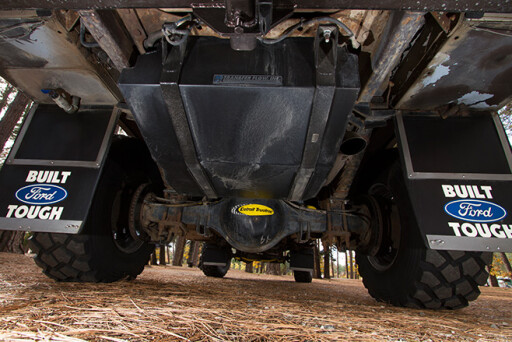 Fore and aft Hellwig sway bars, along with rear Hellwig air-assist bags control bodyroll and the additional weight of the onboard house. The OE duallies were exchanged for Michelin 335/80/R20 XZL MPT tyres on custom 20x11in Rickson wheels.
Fore and aft Hellwig sway bars, along with rear Hellwig air-assist bags control bodyroll and the additional weight of the onboard house. The OE duallies were exchanged for Michelin 335/80/R20 XZL MPT tyres on custom 20x11in Rickson wheels.
A Lee hydraulic ram assist keeps them rolling down the road in a straight line. Because the failure of a 41-inch tyre can be disastrous, a SmarTire wireless pressure/temperature monitoring system was added. The final configuration has provided a functional and reliable suspension that is reasonably comfortable.
 The decision to maintain a stock-height suspension mandated trimming the fenders to eliminate rubbing. Bushwacker stepped in to assist and used the Turtle as a template to fabricate its first Super Duty cutout fender flares.
The decision to maintain a stock-height suspension mandated trimming the fenders to eliminate rubbing. Bushwacker stepped in to assist and used the Turtle as a template to fabricate its first Super Duty cutout fender flares.
Dana 60 and 135S axles, which are fitted with an ARB Air Locker and Eaton Detroit Truetrac respectively, are kept contaminant-free by K&N breathers and take no issue with the 550’s 17,500-pound (7938kg) GVWR. Dynatrac Free-Spin hubs were installed up front after two sets of the factory unit bearings failed.
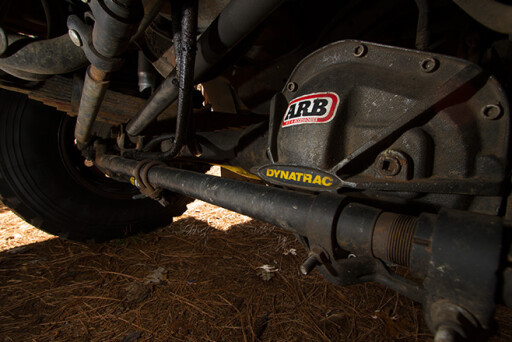 Twin Extreme Outback compressors and an AccuAir 5-gallon (19-litre) tank support the ARB locker, air bags and Fiamm air horns, as well as power pneumatic tools and any tyre needs. With long hauls through remote regions in its future, a Transfer Flow 33.8-gallon (128-litre) auxiliary fuel cell was installed, increasing capacity to 75 gallons (284 litres) and providing a range of 1000 miles (1600km). A custom switchover valve manages tank selection.
Twin Extreme Outback compressors and an AccuAir 5-gallon (19-litre) tank support the ARB locker, air bags and Fiamm air horns, as well as power pneumatic tools and any tyre needs. With long hauls through remote regions in its future, a Transfer Flow 33.8-gallon (128-litre) auxiliary fuel cell was installed, increasing capacity to 75 gallons (284 litres) and providing a range of 1000 miles (1600km). A custom switchover valve manages tank selection.
UNDER THE BONNET AND RECOVERY
THE BASE vehicle is a 1999 Ford F-550 equipped with a Navistar 7.3-litre Power Stroke intercooled turbo-diesel and six-speed manual transmission. The mill, which was the one millionth Power Stroke off the assembly line, generates 305hp (227kW) and 550lb-ft of torque (746Nm). The OE air filter was tossed in lieu of a more space-efficient system, and Bacon fabricated a custom tray for a K&N high-flow washable unit and Outerwears Pre-Filter.
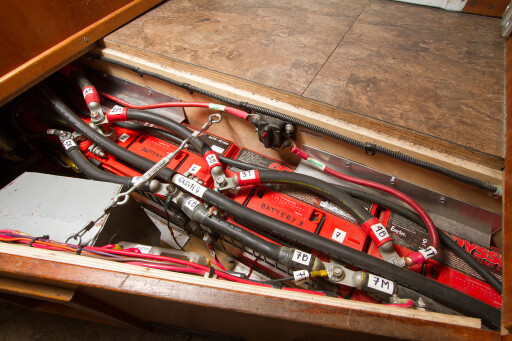 The truck was ordered with the ambulance package, which allowed for an auxiliary alternator. An externally regulated Prestolite/Leece-Neville high-output unit is managed by a Balmar Max marine charge controller and dedicated to charging an array of ‘house’ batteries. Bringing the Power Stroke to life is a pair of Odyssey Extreme Series batteries and MPA Xtreme starter. Other improvements include an ATS Aurora 3000 turbo, Dieselsite high-pressure oil pump, and Dieselsite coolant filter.
The truck was ordered with the ambulance package, which allowed for an auxiliary alternator. An externally regulated Prestolite/Leece-Neville high-output unit is managed by a Balmar Max marine charge controller and dedicated to charging an array of ‘house’ batteries. Bringing the Power Stroke to life is a pair of Odyssey Extreme Series batteries and MPA Xtreme starter. Other improvements include an ATS Aurora 3000 turbo, Dieselsite high-pressure oil pump, and Dieselsite coolant filter.
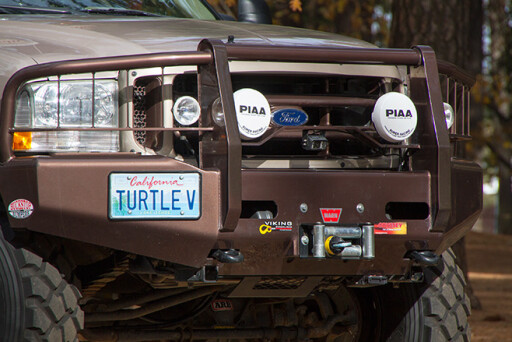 The Buckstop bumper holds an array of PIAA long-range driving and fog lights, as well as a Warn 16,500-pound winch spooled with Viking synthetic line. It has lockable storage compartments on each side, mounts for GoPro and Total Vision cameras, and dual 2in receivers that double as Hi-Lift jack points. A Lund Industries X-Terminator Wrap bug shield (interchangeable with their winter shield) was installed to protect the radiators and coolers from gravel, kamikaze birds and bugs.
The Buckstop bumper holds an array of PIAA long-range driving and fog lights, as well as a Warn 16,500-pound winch spooled with Viking synthetic line. It has lockable storage compartments on each side, mounts for GoPro and Total Vision cameras, and dual 2in receivers that double as Hi-Lift jack points. A Lund Industries X-Terminator Wrap bug shield (interchangeable with their winter shield) was installed to protect the radiators and coolers from gravel, kamikaze birds and bugs.
OFFICE ERGONOMICS
WHEN your office is equipped with a steering wheel, crafting it to be ergonomically comfortable as well as functional can make life on the road a joy. When in the midst of a monsoon or trudging through the emptiness of the Gobi Desert, quick reference to critical vehicle functions is a must.
 The cab was initially stripped down and treated with easy-to-clean Rhino lining and Kraco multi-season rubber floor mats. Dynamat was added to the floor, doors and hood to add a measure of noise abatement. Recaro orthopaedic seats with MasterCraft four-point harnesses were installed, and Halon fire extinguishers are within arm’s reach on both sides of the cab. A custom walnut console provides handy access to maps and small items. Overhead is a Cobra CB, Optronics map lights, JRV auxiliary light switches and SmarTire monitor. To aid in hydration on the road, Platypus Big Zip water bags hang from the back of each seat.
The cab was initially stripped down and treated with easy-to-clean Rhino lining and Kraco multi-season rubber floor mats. Dynamat was added to the floor, doors and hood to add a measure of noise abatement. Recaro orthopaedic seats with MasterCraft four-point harnesses were installed, and Halon fire extinguishers are within arm’s reach on both sides of the cab. A custom walnut console provides handy access to maps and small items. Overhead is a Cobra CB, Optronics map lights, JRV auxiliary light switches and SmarTire monitor. To aid in hydration on the road, Platypus Big Zip water bags hang from the back of each seat.
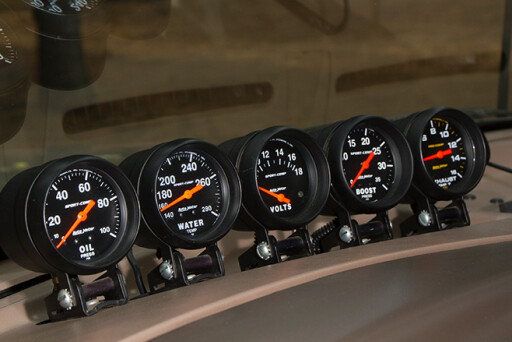 A full array of mechanical AutoMeter Pro-Comp gauges ride on the dash in clear view of the driver, as does a Garmin GPS and bright red AutoMeter Pro-Lite (alerts the driver of a sudden drop in oil pressure). A display monitor was added for the Total Vision front, rear and interior cameras, and an Airguide interior/exterior temperature gauge keeps the pilot apprised of possible icing on the road. Due to the F-550’s 30-inch doorsill height (Monika is petite in stature), a set of Kodiak Sidewinder steps which automatically deploy when a door is opened were installed.
A full array of mechanical AutoMeter Pro-Comp gauges ride on the dash in clear view of the driver, as does a Garmin GPS and bright red AutoMeter Pro-Lite (alerts the driver of a sudden drop in oil pressure). A display monitor was added for the Total Vision front, rear and interior cameras, and an Airguide interior/exterior temperature gauge keeps the pilot apprised of possible icing on the road. Due to the F-550’s 30-inch doorsill height (Monika is petite in stature), a set of Kodiak Sidewinder steps which automatically deploy when a door is opened were installed.
A TURTLE IS ONLY AS GOOD AS ITS SHELL
TURTLES, though they move slowly and with purpose, do have their own limitations. Their bodies are wide, which can limit passage through narrow, mud-walled streets of third-world villages. Size and weight can be the nemesis of overland vehicles, and these factors were at the forefront of the Wescott’s minds when it came to their ‘shell’.
.jpg ) The superstructure consists of an aluminium exoskeleton fitted with Nida-Core extruded polypropylene composite honeycomb panels skinned with a thin layer of fibreglass. The panels, which are attached to the frame with Sikaflex marine adhesive, are lightweight, provide excellent insulation and are extremely rigid. German-made Seitz dual-pane windows feature roll-up privacy shades and roll-down mosquito nets. Cab-over designs provide an instant bed and additional storage, but aerodynamics and height considerations won out, thus the tapered nose and walls.
The superstructure consists of an aluminium exoskeleton fitted with Nida-Core extruded polypropylene composite honeycomb panels skinned with a thin layer of fibreglass. The panels, which are attached to the frame with Sikaflex marine adhesive, are lightweight, provide excellent insulation and are extremely rigid. German-made Seitz dual-pane windows feature roll-up privacy shades and roll-down mosquito nets. Cab-over designs provide an instant bed and additional storage, but aerodynamics and height considerations won out, thus the tapered nose and walls.
When travelling across South America and Siberia, the Wescotts learned that traditional four-point mounting systems flex in technical terrain; the torsional effect causes fatigue to the camper’s frame. The solution was a three-point system commonly used on expedition campers. The two front mounts ride on polypropylene pads while the rear pivots on a single centre point, allowing the frame to twist independently of the camper (you can’t twist a box).
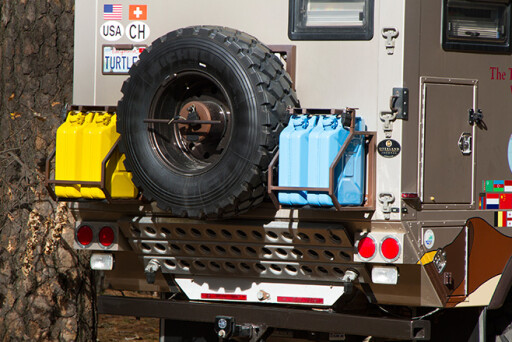 The rear racks hold NATO-style jerry cans and a spare tyre, which is raised and lowered with a one-tonne Maasdam Pow’R Pull manual hoist attached to a removable overhead boom. Below is a set of Darr aluminium sand ladders, and the Hi-Lift jack and gear stow securely in exterior storage compartments. Additional features include PIAA backup/flood lights and Grote SuperNova LED stop/turn indicators.
The rear racks hold NATO-style jerry cans and a spare tyre, which is raised and lowered with a one-tonne Maasdam Pow’R Pull manual hoist attached to a removable overhead boom. Below is a set of Darr aluminium sand ladders, and the Hi-Lift jack and gear stow securely in exterior storage compartments. Additional features include PIAA backup/flood lights and Grote SuperNova LED stop/turn indicators.
THE ABODE
THE INTERIOR is no less than luxurious, albeit in a condensed form. A dedicated bathroom was foregone for a Thetford Porta Potti that slides on tracks into the doorway, which also doubles as a shower stall. A slide-out bed sits in the back, while the front is utilised as a living room, dinette and work space.
 Under the seating area is a 40-gallon (151-litre) water tank and Hunter radiator that keeps the camper warm while on the road. A diesel Espar Hydronic D5 fluid heater plumbed to a Flat Plate heat exchanger provides continuous hot water and will preheat the engine when needed.
Under the seating area is a 40-gallon (151-litre) water tank and Hunter radiator that keeps the camper warm while on the road. A diesel Espar Hydronic D5 fluid heater plumbed to a Flat Plate heat exchanger provides continuous hot water and will preheat the engine when needed.
 When parked on cold nights, an Espar Airtronic (also diesel) keeps the house toasty warm. Filling electrical power requirements is a bank of Odyssey Extreme Series batteries, kept topped off by a pair of roof-mounted BP 85-watt solar panels. A PROsine 100-amp, 2000-watt inverter provides 110 AC and will charge the batteries when hooked up to shore power.
When parked on cold nights, an Espar Airtronic (also diesel) keeps the house toasty warm. Filling electrical power requirements is a bank of Odyssey Extreme Series batteries, kept topped off by a pair of roof-mounted BP 85-watt solar panels. A PROsine 100-amp, 2000-watt inverter provides 110 AC and will charge the batteries when hooked up to shore power.
The galley consists of a Magic Chef three-burner propane stove, Dometic CoolMatic compressor refrigerator/freezer (12V/110V) and two sinks. There is ample counter space and loads of storage. With diesel hot water and heat, the two 20-pound (18kg) Manchester LPG tanks are sufficient for three months on the road and can be filled anywhere in the world. Even with the aforementioned luxuries of indoor living at their disposal, Gary and Monika prefer the outdoors. To starboard is a Fiamma crank-out awning for sunny days and rainy nights.
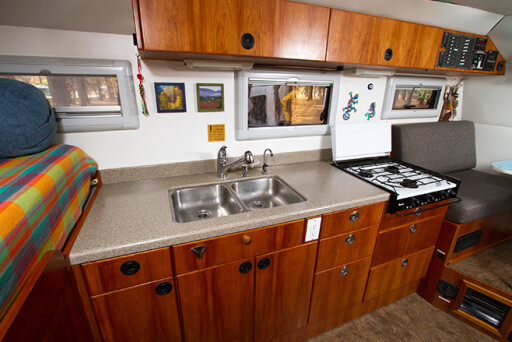 The Turtle V was designed by Gary and Monika (with a pencil and paper) and built with the assistance of craftsmen from around the US. The only major failure was the house door, which was replaced with a custom, one-off unit from Global Expedition Vehicles. Considering it was completed in 2000 (if any build is ever complete) and continues to stand in a class of its own after traversing dozens of countries and spinning the odometer to almost 322,000km, one could argue that The Turtle V is the ultimate live-on-the-road overlander.
The Turtle V was designed by Gary and Monika (with a pencil and paper) and built with the assistance of craftsmen from around the US. The only major failure was the house door, which was replaced with a custom, one-off unit from Global Expedition Vehicles. Considering it was completed in 2000 (if any build is ever complete) and continues to stand in a class of its own after traversing dozens of countries and spinning the odometer to almost 322,000km, one could argue that The Turtle V is the ultimate live-on-the-road overlander.
As a last question we asked Gary why there is no Australian flag among the many on the back of Turtle V. “Ever since being one of the American journalists on the 1986 Australian Camel Trophy, I have wanted to return to see Australia at my own pace,” he replied. “We have always said, yeah, Australia is on our bucket list, but we’ll do it when were old. It is such a safe place to travel with your own vehicle, but we wouldn’t attempt it unless we had a full year. Getting The Turtle V cleaned and certified for Australian customs might be a challenge in itself.”
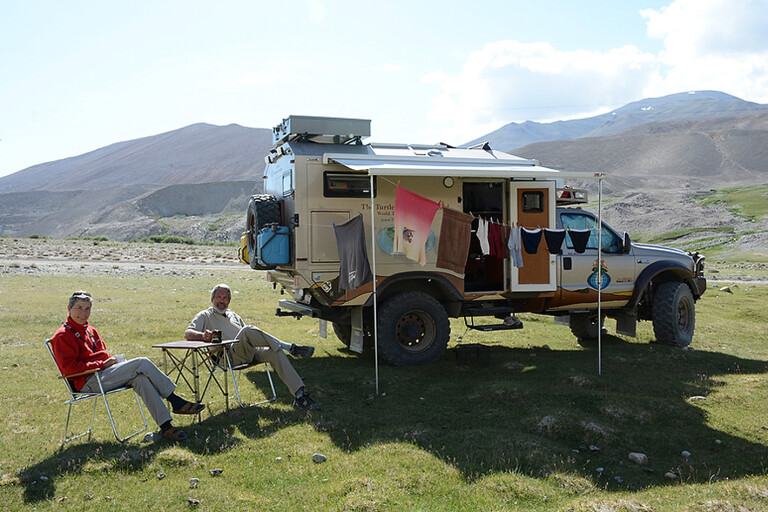
SPECS: 1999 Ford F-550
Engine: Navistar 7.3L turbo-diesel, ATS Aurora 3000 turbo
Output: 305hp @ 3200rpm; 550 lb-ft @ 2000 rpm (227kW/746Nm)
Transmission: OE
Transfer Case: 450Nm @ 1600-2400rpm
Axles: Dana 60, Dana 135S
Differentials: ARB Air Locker, Eaton Detroit Truetrac
Tyres/wheels: Michelin 335/80/R20 XZL MPT, 20x11in Rickson
Suspension: National springs, Rancho RS9000XL shocks
Steering: Lee hydraulic assist
Rear suspension: live axle/coil springs
Bumper: Buckstop custom
Recovery: Warn 16,500-lb winch, Viking synthetic rope, Hi-Lift
Fuel cell/gal/range: Transfer Flow/ 75 gal (284 litres)/ 1600km range
Compressor: Extreme Outback Extreme Air
Batteries: Odyssey Extreme (6)
Lighting: PIAA, Grote SuperNova
Check out more custom rigs here
TURTLE TIMELINE
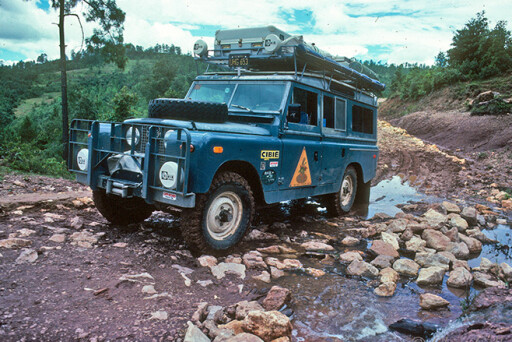 TURTLE I (1970-1981)
TURTLE I (1970-1981)
When Gary Wescott came up with the idea of travelling around the world in a four-wheel drive, a Land Rover seemed like the obvious choice. The Turtle I, Tortuga Azul (Blue Turtle), was a 1967 Land Rover 109 with the spare traditionally mounted on the hood. Gary designed the interior to sleep two occupants and carry enough gear for a five-year trek through Central and South America. The original Rover 2000 petrol mill was eventually traded for a Chevrolet 250 six-cylinder engine. It was fitted with stock bumpers, Dick Cepek tyres and a Warn 8000-pound winch.
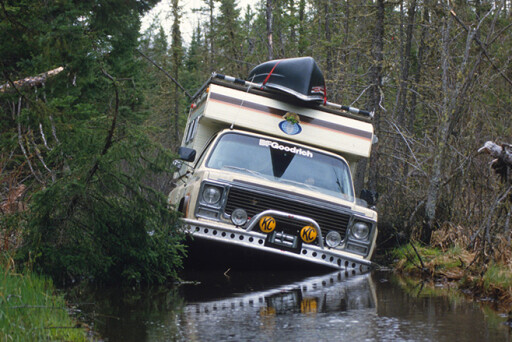 TURTLE II (1981-1988)
TURTLE II (1981-1988)
The second Turtle, a Chevy 4WD pick-up, carried a pop-up camper to improve life on the road. The original Callen abode lacked the utility needed and was replaced with a Four Wheel Camper, which served as the Wescott’s home until 1988. After having issues with the original 350 V8, the Turtle II received a big-block 454 and TH400 auto transmission. Accessories included Hobrecht bumpers, a Warn winch, BFGoodrich Mud Terrain tyres, and a Rough Country suspension. A big improvement over the Turtle I was the ability to carry an aluminium fishing boat and an outboard motor up top.
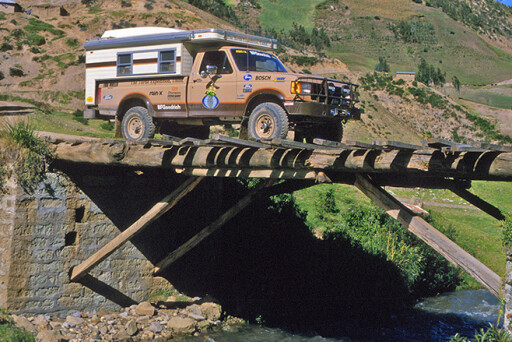 TURTLE III (1987-1996)
TURTLE III (1987-1996)
In 1987, after having their adventure stories printed in numerous mags, Gary and Monika were noticed by Ford Motor Company. They were provided with an F-350 4WD powered by a 6.9-litre International diesel and four-speed manual, the Turtle III. It too received a Four Wheel Camper and Warn winch, along with ARB locking differentials, Alco wheels and BFGoodrich tyres. Its first adventure was a 50,000-mile, 14-month trek through South America, which included the Atacama Desert, the jungles of the Amazon, and 16,000-foot passes of the Andes. Prior to being retired in 1996 it received a new 7.3-litre Navistar turbo-diesel.
 TURTLE IV (1992-2001)
TURTLE IV (1992-2001)
With a 36,000-mile expedition around the Northern Hemisphere in the works, the Turtle IV, a Ford F-350 turbo-diesel, included mods specifically designed to withstand -60°C conditions. The 7.3-litre Navistar diesel, Four Wheel Camper and cab were upfitted with engine and fuel preheaters, diesel space-heaters, high-tech insulation and a trailer to haul fuel. The Turtle IV had ARB lockers, Rancho suspensions, BFG tyres, a Mile Marker winch, National Springs, Optima batteries, and a K&N air filter and intake system. The Turtle IV completed the wintery expedition before being retired in 2001.

COMMENTS